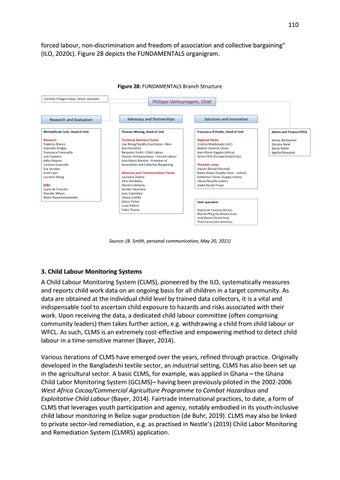110 forced labour, non-discrimination and freedom of association and collective bargaining” (ILO, 2020c). Figure 28 depicts the FUNDAMENTALS organigram.
Figure 28: FUNDAMENTALS Branch Structure
Source: (B. Smith, personal communication, May 20, 2021)
3. Child Labour Monitoring Systems A Child Labour Monitoring System (CLMS), pioneered by the ILO, systematically measures and reports child work data on an ongoing basis for all children in a target community. As data are obtained at the individual child level by trained data collectors, it is a vital and indispensable tool to ascertain child exposure to hazards and risks associated with their work. Upon receiving the data, a dedicated child labour committee (often comprising community leaders) then takes further action, e.g. withdrawing a child from child labour or WFCL. As such, CLMS is an extremely cost-effective and empowering method to detect child labour in a time-sensitive manner (Bayer, 2014). Various iterations of CLMS have emerged over the years, refined through practice. Originally developed in the Bangladeshi textile sector, an industrial setting, CLMS has also been set up in the agricultural sector. A basic CLMS, for example, was applied in Ghana – the Ghana Child Labor Monitoring System (GCLMS)– having been previously piloted in the 2002-2006 West Africa Cocoa/Commercial Agriculture Programme to Combat Hazardous and Exploitative Child Labour (Bayer, 2014). Fairtrade International practices, to date, a form of CLMS that leverages youth participation and agency, notably embodied in its youth-inclusive child labour monitoring in Belize sugar production (de Buhr, 2019). CLMS may also be linked to private sector-led remediation, e.g. as practised in Nestle’s (2019) Child Labor Monitoring and Remediation System (CLMRS) application.













